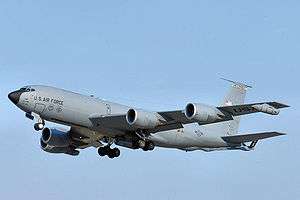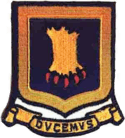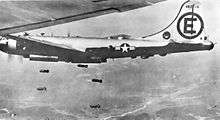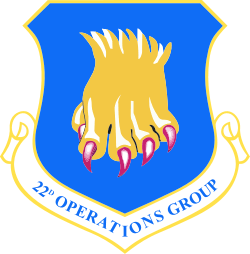22d Operations Group
| 22d Operations Group | |
|---|---|
|
Emblem of the 22d Operations Group | |
| Active | 1940–1952; 1991–present |
| Country | United States |
| Branch | United States Air Force |
| Role | Air Refueling |
| Motto(s) | Ducemus – "We Lead" |
| Commanders | |
| Current commander | Col Ron Langford |

The 22d Operations Group (22 OG) is the operational flying component of the United States Air Force 22d Air Refueling Wing. It is stationed at McConnell Air Force Base, Kansas, and is assigned to the Air Mobility Command (AFGSC) Eighteenth Air Force.
The 22d OG primary mission is to provide global reach by conducting air refueling and airlift where and when needed. The group directs the 22d Refueling Wing's KC-135R Stratotanker refueling and airlift operations in support of worldwide AMC, U.S. Transportation Command, Air Force, Department of Defense, and allied operations anywhere in the world.
The group's World War II predecessor unit, the 22d Bombardment Group was one of the first U.S. Army Air Force units to be deployed into the Pacific Theater after Pearl Harbor with the Martin B-26 Marauder medium bomber. It operated primarily in the Southwest Pacific Theater as a B-25 Mitchell unit assigned to Fifth Air Force. It was awarded two United States Distinguished Unit Citations and the Philippine Presidential Unit Citation for its combat service in China; Netherlands East Indies; New Guinea; the Bismarck Archipelago; the Western Pacific; Leyte and Luzon.
During the early years of the Cold War, the group moved temporarily to Okinawa in July 1950 and attached to Far East Air Forces for duty in the Korean War. It began combat immediately, and until October 1950 attacked marshalling yards, bridges, highways, airfields, and industries and supported UN ground forces in Korea.
Overview
The 22d Operations Group uses five squadrons and their assigned personnel to execute the wing's challenging and diverse refueling and airlift missions, from CONUS refueling support to unit deployments in support of theatre operations worldwide.
- 344th Air Refueling Squadron
- 349th Air Refueling Squadron
- 350th Air Refueling Squadron
- 384th Air Refueling Squadron
- With these air refueling squadrons, the group supervises operations in support of strategic force projection and mobility, special operations, tactical air operations, and humanitarian assistance efforts.
- 22d Operations Support Squadron
- The squadron provides airfield management, air traffic control, intelligence, combat crew communications, base weather service, mission scheduling, planning, and combat tactics.
History
- For additional history and lineage, see 22d Air Refueling Wing
Origins
The authorizing document was a letter issued by the Adjutant-General's Office titled "The Constitution and Activation of Certain Air Corps Units". Lieutenant Colonel Ross F. Cole was the first Group Commander.
The first elements of the Group included:
- 2d Bombardment Squadron, commanded by Captain Leslie P. Halcomb
- 19th Bombardment Squadron, commanded by 1st Lieutenant Herman E. Hurst
- 33d Bombardment Squadron, commanded by 1st Lieutenant Theodore E. Graff
- 18th Reconnaissance Squadron (later became 408th Bombardment Squadron), commanded by Captain John P. Doyle.
The Group was located at Langley Field, Virginia. Its first aircraft were a few B-18 Bolo bombers, with a few B-25 Mitchell bombers allocated to the 18th Reconnaissance Squadron.
In 1941 the Group transitioned to B-26 Marauder bombers, a fast bomber with very specialized aerodynamic capabilities. These capabilities included short, stubby wings, which led the plane to be known as "The Flying Prostitute" (no visible means of support). However its flying characteristics led to many crashes, which also led to the plane being known as "The Flying Coffin".
Throughout 1941 the 22d BG trained extensively, increasing in intensity in November 1941. It was so combat ready that 16 hours after the Japanese attack on Pearl Harbor on 7 December 1941, the 44 planes of the 22d BG headed for the West Coast and on to the South West Pacific.

World War II
![]() Media related to United States Army Air Forces 22d Bombardment Group at Wikimedia Commons
Media related to United States Army Air Forces 22d Bombardment Group at Wikimedia Commons

The Group prepared itself at Muroc Army Air Field in the Mojave Desert in California from 15 December 1941 and began patrols of the west coast. A ground crew team left San Francisco on 31 January 1942 for Brisbane, Queensland in Australia.
On 6 February 1942, the Group's aircraft were shipped to Hickam Field (arriving about a week later). They immediately commenced patrol duties.
On 22 March 1942, the first flight of the 22d air echelon arrived at Amberley Field. near Brisbane in Australia, and became the first fully armed Air Force Group to fly the Pacific en masse. They were warmly welcomed by the Australians who were concerned that, while the Japanese were threatening Australia, its troops were fighting the Germans in the Middle East.
Shortly after arriving in Australia, the Group (now under the command of Lieutenant Colonel Millard L. Haskin) moved further North to the Townsville area:
- 2d Bombardment Squadron (commanded by 1st Lt George R. Anderson) was based at Reid River, about 40 miles South of Townsville
- 408th Bombardment Squadron (commanded by Captain Brian O'Neill) was also based at Reid River
- 19th Bombardment Squadron (commanded by 1st Lt Elliott H. Reed) was based at Garbutt field.
- 33d Bombardment Squadron (commanded by 1st Lt William A. Garnett) was based Antill Plains, 20 miles South of Townsville.
On 5 April 1942, the 22d BG took off from Garbutt Field for its first combat action, an attack on Rabaul in New Britain (North of New Guinea). In this attack on the Japanese Naval Base, the Group sunk a transport ship but lost a plane and the life of S/Sgt Bourne.
Meanwhile, four B-26 Marauders, including two from the 18th Reconnaissance Squadron, left behind at Hawaii, saw action on 4 June 1942 as part of the air attack in the Battle of Midway, and were the first Army planes to make a torpedo attack. These planes, piloted by 1st Lieutenant Herbert C. Mayes and 1st Lieutenant James P. Muri attacked the Japanese Naval Invasion Force, focusing torpedo and strafing action on its aircraft carrier. Lt Muri's plane, badly damaged with over 500 bullet and shrapnel holes, crash landed. [Lt Muri's account: https://www.youtube.com/watch?v=CSm055a0394] [Alternate URL for broken link (same original commentary): https://www.youtube.com/watch?v=6E67kmx3aWg&t=7m18s]
In 1944, the group converted from medium, twin engined B-25 Mitchell and B-26 marauder bombers to heavy four engined B-24 Liberator bombers. Following its conversion to B-24 Liberators, on 11 February 1944 the 22d Bomb Group was redesignated 22d Bomb Group, Heavy. The Group was tasked to bomb Japanese airfields, shipping, and oil installations in Borneo, Ceram, and Halmahera. It began raiding the southern Philippines in September 1944 to neutralize Japanese bases in preparation for the invasion of Leyte.
From December 1944 to August 1945, the Group struck airfields and installations on Luzon, supported Australian ground forces on Borneo, and bombed railways and industries in Formosa and China. Near the end of the war the 22 BG moved to Okinawa in August 1945 and flew some armed reconnaissance missions over southern Japan.
Postwar era
The 22 BG's staff and aircraft were released and the Group moved to Clark Air Base in the Philippines in November 1945. In April 1946 the 22 BG returned to Okinawa as the 22d Bombardment Group (Very Heavy), and was remanned and assigned B-29 Superfortress bombers, operating from Kadena Air Base. In May 1948, moved to the United States to serve Strategic Air Command (SAC).
Korean War

The 22d was one of two SAC groups selected to deploy to the Pacific after SAC was directed to reinforce the 19th Bombardment Wing of Far East Air Forces. The 22d was selected because removing it from SAC control would have a minimum impact on the SAC mission because its planes were not yet equipped for the delivery of nuclear weapons and would not impact SAC's task of building a credible deterrent to the Soviet Union.[1] The 22d Bombardment Group deployed its B-29 Superfortresses in early July 1950 to Kadena AB, Okinawa, where it came under control of FEAF Bomber Command (Provisional). On 13 July, the group flew its first mission, against the marshalling yards and oil refinery at Wonsan, North Korea. By 21 October, it had amassed fifty-seven missions against the enemy, attacking bridges, factories, industrial targets, troop concentrations, airfields, marshalling yards, communications centers, and port facilities. During four months of combat, the group flew 335 sorties with only fourteen aborts and dropped over 6,500 tons of bombs.
When the 22d returned to March AFB is late October or early November 1950, 335 sorties had been flown. One plane, 44-62279,[2] was reported lost during operations from Okinawa. Combat components of the group were the 2nd, 19th and 33rd Bombardment Squadrons. It became a records unit in February 1951, inactivated on 16 June 1952.
Modern era
After activation in 1991, commenced air refueling missions. Using KC-10 aircraft, the group airlifted humanitarian equipment and supplies to Somalia, 1992–1994. Deployed group aircrews and aircraft on other contingency operations in many parts of the world, including Haiti in 1994 and Serbia in 1999. The group also refueled aircraft enforcing no-fly zones over Bosnia-Herzegovina in the mid-1990s and over northern and southern Iraq between 1992 and 2002.
After terrorist attacks in the United States in September 2001, deployed crews and aircraft for operations in Afghanistan.
Lineage
- Established as 22d Bombardment Group (Medium) on 22 December 1939
- Activated on 1 February 1940
- Redesignated: 22d Bombardment Group, Heavy, on 11 February 1944
- Redesignated: 22d Bombardment Group, Very Heavy, on 15 June 1946
- Redesignated: 22d Bombardment Group, Medium, on 28 July 1948
- Inactivated on 16 June 1952
- Redesignated: 22d Air Refueling Group, Heavy, on 31 July 1985 (Remained inactive)
- Redesignated: 22d Operations Group on 29 August 1991
- Activated on 1 September 1991.
Assignments
|
|
Components
World War II/Korean War
- 2d Bombardment Squadron: 1 February 1940 – 16 June 1952 (detached 10 February 1951 – 16 June 1952)
- 18th Reconnaissance (later, 408th Bombardment) Squadron: attached 1 February 1940 – 24 April 1942; assigned 24 April 1942 – 29 April 1946
- 19th Bombardment Squadron: 1 February 1940 – 16 June 1952
- 22d Air Refueling Squadron: 16 June 1950 – 16 June 1952
- 33d Bombardment Squadron: 1 February 1940 – 16 June 1952
Modern era
- 6th Air Refueling Squadron: 1 September 1991 – 1 January 1994
- 9th Air Refueling Squadron: 1 September 1991 – 1 January 1994
- 344th Air Refueling Squadron: 29 April 1994–present
- 349th Air Refueling Squadron: 1 January 1994–present
- 350th Air Refueling Squadron: 1 July 1994–present
- 384th Air Refueling Squadron: 1 January 1994–present
- 459th Airlift Squadron, 1 April – 1 October 1993.
Stations
|
|
Aircraft
|
|
See also
References
Notes
- ↑ Deaile, pp. 167-168
- ↑ Ranter, Harro. "ASN Aircraft accident 19-OCT-1950 Boeing B-29A Superfortress 44-62279". aviation-safety.net. Retrieved 2016-10-06.
Bibliography
![]() This article incorporates public domain material from the Air Force Historical Research Agency website http://www.afhra.af.mil/.
This article incorporates public domain material from the Air Force Historical Research Agency website http://www.afhra.af.mil/.
- Claringbould, Michael John, "The Forgotten Fifth"
- Deaile, Melvin G. (2007). The SAC Mentality: The Origins of Organizational Culture in Strategic Air Command 1946-1962. Chapel Hill, NC: University of North Carolina. Retrieved February 14, 2015.
- Hickey, Lawrence J (Warpath Across the Pacific), Walter Gaylor (World War II vet & 22d Bomber Group historian) and Don Evans & Harry Nelson, (who served with the 22d), "Revenge of the Red Raiders", 2006 [ISBN 0-913511-05-6]
- 22d Operations Group Factsheet
Further Reading
- Brosius, Jr., J.W. (1944). The Marauder:A Book of the 22nd Bomb Group. Sydney, Australia: Halstead Press.
- Schroeder, Frederick A. (1985). Ducimus "We Lead" 22nd Bomb Group. Daytona Beach, FL: Hall Publishing Co.
- Watkins, Robert A. (2013). Insignia and Aircraft Markings of the U.S. Army Air Force In World War II. Volume V, Pacific Theater of Operations. Atglen,PA: Shiffer Publishing, Ltd. pp. 72–73. ISBN 978-0-7643-4346-9. (Markings of unit B-24, B-25 and B-26 aircraft during World War II)
External links
- 22d Bomb Group in Australia during World War II
- The International B-24 Museum: 22d BG: http://web.archive.org/web/20080828044942/http://www.pwam.org/virtual_museum/22bghst.htm
- Walt Gaylor, Lawrence J Hickey (2007). "Revenge of the Red Raiders: The Illustrated History of the 22d Bombardment Group in World War II". Boulder, CO: International Research and Publishing Corp. Archived from the original on 21 August 2009.
- 22d BG Warbirds on the Web
- Video of B-26 belly landing at Port Moresby (This is a survivor of the mission in which Lyndon Johnson was awarded his Silver Star).
Personal Accounts
2nd Squadron
- Jim Houston: http://www.pacificwrecks.com/people/veterans/houston.html
- Lt Col Robert W Hulme: http://www.tennesseesoul.com/history/raidonpalau.html
- Sgt Lloyd Bunting Jr: http://bunting.com.au/vj60/cf.php
- Sgt Hager Blair: http://bunting.com.au/vj60/cf_x1.php
19th Squadron
- Merrill S. Matthews: http://www.b26.com/marauderman/merrill_matthews.htm
33rd Squadron
- Hugh Manson: http://www.b26.com/marauderman/hugh_manson.htm



.svg.png)
.jpg)
